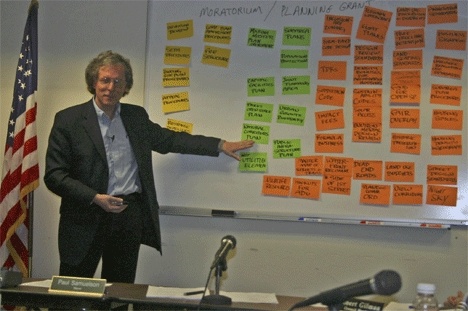LANGLEY — The Langley City Council and the community got their chance last week to pitch their top picks for changing policies that will guide growth over the next two decades.
Planning chief Larry Cort, who had come up with a list of changes to Langley’s rule books based on the growth plan rewrite that was finalized in December, invited everyone to add ideas.
In no time, colorful sticky notes were plastered over the wall in the council chamber. The notes were broken down on administrative issues, policies and guiding documents and wishes voiced by the community during the comprehensive plan process. Topics included protection for Langley’s greenbelt and open space.
The city council will begin prioritizing the issues at its regular meeting on March 19.
While the community will have some input, Cort said some issues will bubble to the top of the list based on their nature.
“Some aspects will put issues higher up on the list,” Cort said.
At the top of the list: Codes and policies that will help lift the subdivision moratorium that was put in place last summer. Those are needed because the city’s insurance carrier won’t support the long-term ban on building.
“We have to actively work to get this moratorium lifted,” he said.
Councilman Robert Gilman added that work on the subarea plans is important, too, because the city received a $45,000 grant last year to help implement them. The state wants to see progress.
“By the end of 2008, we need to report … about our sub-area procedures. By the middle of 2009 we need sub-area plans,” Gilman said. “They won’t come and haul us off if we don’t make it, they just won’t pay us the money.”
Councilman Russell Sparkman said he would like to see waterfront development regulations dealt with as soon as possible.
Cort added that the overlay zoning for the fairgrounds is another issue that has high priority because it was part of the agreement between the city and the county to end the legal battle over Fairgrounds Road.
He also said in some cases the city can’t put the wagon before the horse.
“A number of these things depend on something else being done first,” Cort said.
“It would be very difficult to make a case for impact fees without a capital facilities plan in place,” he explained.
Cort also made suggestions about how to approach the creation of new policies and codes. He said the city shouldn’t only focus on restrictions.
“We don’t just want to prevent what’s bad, but define what’s good,” he said.
Cort also suggested that some rules should apply to existing structures as well as vacant lots.
He also stressed that a detail-driven revision of Langley’s rules would be good for Langley because developers could get an idea about what size and scale is acceptable for Langley. Size and scale is one of the major points of contention in the waterfront discussion. Critics have said projects recently proposed by two developers were too large for Langley.
“Form-based codes are not to stifle creativity,” he said. “Scale and size are the bread and butter of form-based code.”
The community also got their say what issues they want to see tackled.
Eric Levine, the author of a controversial comp plan greenbelt proposal, said he wanted to make sure a tree ordinance was on the list.
Marianne Edain of WEAN wanted it to be taken one step further.
“I would like native plant communities protected,” she said.
However, some audience members raised the issue that while trees are a great thing, properties also should get enough sun, especially as solar energy becomes more important. So a sticky note was added that planners should consider solar access.
Rhonda Salerno stressed that the city should consider an Environmental Design Review Board.
Mark Wahl said some ordinances may be easy and therefore could be done quickly.
For instance, the county has already a dark sky ordinance and the city could simply adopt something similar, he said.
In the end, more than 60 colorful sticky notes graced the walls.
“If those were animals, some of them are muskrats and some of them are elephants,” Cort said as he looked them over.
Cort added it will take several years to implement all the changes.
Later in the meeting, Gilman introduced a outline on managing the policy workflow.
The paper essentially suggested that a policy progress coordinator would receive and keep track of new policy drafts.
Elected officials and staff would then prioritize changes and integrate them into the workflow, before they are researched and crafted into draft code.
But some audience members feared that the new process would cut out early public participation or would allow the policy coordinator to edit suggestions based on his preferences.
Others feared that it would take away power from Langley’s Planning Advisory Board.
However, both Planning Advisory Board and council members said they would welcome exchanging information sooner and working together more closely.



